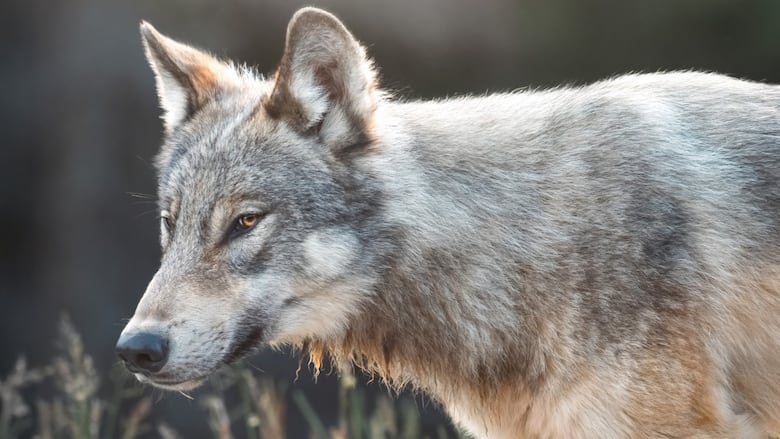Rare encounters with K-Country wolf surprise visitors, make Alberta Parks staff wary
Lone predator appears unfazed by people, could possibly be seeking human food

A lone grey wolf encountered by multiple people in Kananaskis Country has possibly become acclimated to the presence of humans, according to Alberta Parks.
In a statement to CBC News, Ministry of Forestry and Parks press secretary Neil Singh said the wolf has been seen in campgrounds and along the road on numerous occasions.
"The wolf appears to be habituated and does not avoid people as wild wolves typically do," Singh said.
"Conservation officers and Alberta Parks staff are monitoring the situation, and have been using aversive conditioning methods when possible, to discourage the wolf from approaching people."

Spotting the wolf on the evening of July 16 was longtime wildlife photographer Alec McGrath's first time seeing one up close.
"I've been waiting for the last four years to find one ever since I moved out," the Canmore resident told CBC News.
He said he was surprised to see the wolf trotting along Highway 40 in Peter Lougheed Provincial Park, an area popular with travellers.
"Every so often he would look back behind him and check to see if someone else was coming, keep trotting up the road, look back one more time, check to see if anybody else was coming, and he did that several times," McGrath said.

McGrath said while the wolf did not appear bothered by him or other passing vehicles, it didn't approach his vehicle either.
Audrey Niles, another traveller who saw the wolf earlier that morning, said the wolf seemed to ignore her vehicle as it passed.
"I was kind of surprised to see that this wolf paid no attention to us or our vehicle … it was definitely not how I expected a wolf to act," she said.
Wolf is possibly 'food-conditioned'
In his statement, Singh said "while we cannot confirm what has caused this behaviour, the wolf may have accessed or received human food or rewards from the public, potentially leading to it becoming food-conditioned."
Singh's statement did not indicate when or where exactly the problematic wolf had been seen.
As of publication time, there are no public advisories in place regarding this wolf, though multiple warnings and closures have been issued throughout Kananaskis Country due to bear activity.
The behaviour described by McGrath is "absolutely not" typical for a wild wolf, said Nick de Ruyter, program director of the BioSphere Institute's WildSmart program.
"Wolves typically are wary of people, and will do their best to stay away from people, so the fact that this wolf isn't afraid of people … definitely tells me that it's food-conditioned and habituated," he said, comparing it to bear habituation.
"Once they're not afraid of people, and don't run away when they see people, that means they're too comfortable," he said. "That's not a good thing."
Once a predatory animal acquires a taste for human food, de Ruyter said, it typically doesn't end well.
"You get an animal that gets bold, more aggressive, and starts approaching people … once it gets to that point, it's almost too late," he said. "There's really no other option other than potentially relocating an animal or euthanizing it."
Government of Alberta data suggests there are around 7,000 grey wolves throughout the province. While seldom seen in the wild, they're not considered an endangered or at-risk species in Alberta.
According to de Ruyter, wolves are rarely encountered in the Bow Valley, especially up close.
"They are certainly around, but we don't really see them that often," he said of the elusive animals, adding that he's come across wolf tracks on numerous occasions and found multiple wolves through trail camera footage, but only ever seen "one or two" in person.

While Alberta Parks did not provide a description of the wolf's appearance, the one seen by McGrath, Niles and others exhibited unusual behaviour consistent with an animal not bothered by human activity.
"Based on all the sightings, I'm sadly willing to bet that is the one," McGrath said.
McGrath said the wolf was "probably a bit larger than an average German shepherd," describing it as likely being a younger animal.
Wolves can typically be distinguished from more common canids like coyotes or stray dogs by their significantly larger size and more muscular build, along with characteristics like rounder ears and more prominent snouts.

